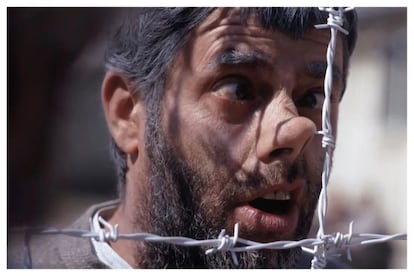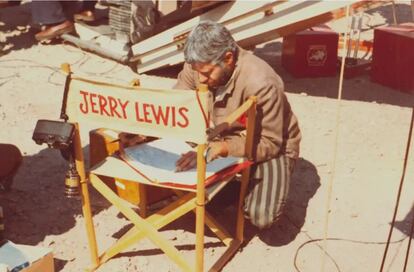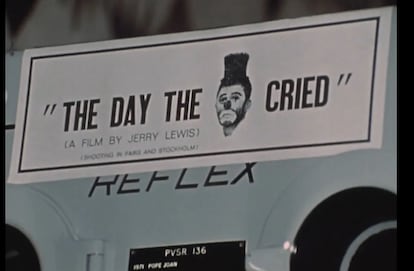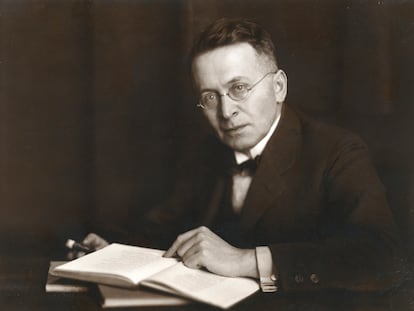The resurrection of Jerry Lewis’ catastrophic Holocaust movie
The Venice Film Festival has premiered the documentary ‘From Darkness To Light,’ which analyzes Jerry Lewis’ ‘The Day the Clown Cried,’ a project that never saw the light of day


US comedian Jerry Lewis never wanted anyone to see The Day the Clown Cried. At least not during his lifetime. He knew that what he had hoped would be a masterpiece had actually turned out to be a monumental disaster and a stain on his career. When he received the honorary Palme d’Or at Cannes in 2013, he said in reference to the film, “No one will ever see it because I’m embarrassed at the poor work. It was all bad and it was bad because I lost the magic.”
Dubbed the King of Comedy, Lewis kept the only copy of the unreleased The Day the Clown Cried. The film tells the story of a clown imprisoned in Auschwitz for mocking Hitler and, like the pied piper, he leads the camp’s children to their deaths in the gas chambers. Last week, the Venice Film Festival screened the documentary From Darkness to Light, by Eric Friedler and Michael Lurie which, based on another documentary and an interview with the comedian himself, attempts to shed some light on a movie Lewis wanted good and buried.
The backbone of From Darkness to Light is provided by Ferne Pearlstein’s The Last Laugh (2016), in which Pearlstein interviews famous comedians about their profession. The heart, on the other hand, lies in the interview Lewis gave to Friedler months before he died in 2017 at age 91. It is an encounter in which the comedian, who was generally wary of the press, let his guard down and talked about the fiasco.
Friedler and Lurie also had access to the original unreleased footage of the film which they incorporate into the documentary – about 30 minutes of which had already appeared on the internet for a period in 2016. Archived in the U.S. Library of Congress, Lewis donated the materials under the condition it would not make them available until 2024.
“We didn’t even think the movie existed,” Martin Scorsese recounts onscreen. “We thought it was a myth.” One person who did see it was the comedian Harry Shearer, who said, “I got access to it because someone had a video copy of the first montage and they passed it on to me for a few days.” His opinion? “You’d just think ‘My God, wait a minute! It’s not funny, and it’s not good, and somebody’s trying too hard in the wrong direction to convey this strongly-held feeling.”

To understand why Lewis decided to direct and star in a drama about the Holocaust, you have to go back to the mid-1960s, when he was considered a movie maestro in France by the most discerning critics who saw in his work a subtly ironic vision of the American way of life. After a performance at the Olympia theater in Paris, a Hungarian producer, Nathan Wachsberger, who owned the rights to a script written by Joan O’Brien and Charles Denton, came to talk to him.
No one else had dared to film that script about a washed-up clown called Helmut Doork who annoys the Nazi guards by entertaining the children of Auschwitz. About to be executed, he is saved when the Nazis suggest that he use his talents to lead the children to the gas chambers. Doork accepts and carries out his task without any acknowledgment of what he is doing. In the end, the children hang onto the clown and ask him, “Where are we going, Helmut?” and all together, singing and laughing, they enter a gas chamber. The doors close.
Lewis took the plunge: he wanted to be a respected moviemaker, and this seemed like as good a chance as any. In early 1972, he lost almost 20 kilos, did pre-production in Paris and hired Harriet Andersson to play his wife. Meanwhile, French star Pierre Étaix would play the clown and German Anton Diffring would play the Nazi who made his life impossible. Halfway through filming in Stockholm, Wachsberger took off with some of the money and the cameras, but that didn’t stop Lewis, who finished the film. When the shoot was over, he took the footage to Los Angeles. There, devastated by how bad it was, he refused to take the project any further, burying it instead.
What went wrong? Scriptwriter Joan O’Brien suggested that it was because she and Denton had written the story of an egotist seeking redemption, and Lewis had rewritten it, looking for his own version of Charlie Chaplin’s The Great Dictator. O’Brien fought to regain the rights to her screenplay which is now once again available should another filmmaker be willing to take it on.
What can be seen of The Day the Clown Cried in the documentary is boring, leaden and disjointed. In one sequence, the clown hooks his nose on the barbed wire. Next to him, another prisoner muses, “When you’re ruled by fear, laughter is the scariest sound in the world.” What is heard, however, are the half-hearted sounds of the Jewish children gathered to watch Helmut on the other side of the fence. Those same children will be the ones who go with the clown in the end to their deaths.

Aimed at a family audience, Lewis’s main shame appeared to lie in the fact that the project failed to properly handle such a delicate topic. “Where was the comedy, if one is taking 65 children to the gas chamber?” he told the German documentary Der Clown.
One critic said that it was wrong to deal with the Holocaust instead of facing Nazism in a broader sense, like Mel Brooks’ The Producers. Another describes the film as ahead of its time: years later, Roberto Benigni did hit the right note in Life is Beautiful. Meanwhile, comedian Harry Shearer summed it up as “so drastically wrong, its pathos and its comedy … so wildly misplaced.”
Sign up for our weekly newsletter to get more English-language news coverage from EL PAÍS USA Edition
Tu suscripción se está usando en otro dispositivo
¿Quieres añadir otro usuario a tu suscripción?
Si continúas leyendo en este dispositivo, no se podrá leer en el otro.
FlechaTu suscripción se está usando en otro dispositivo y solo puedes acceder a EL PAÍS desde un dispositivo a la vez.
Si quieres compartir tu cuenta, cambia tu suscripción a la modalidad Premium, así podrás añadir otro usuario. Cada uno accederá con su propia cuenta de email, lo que os permitirá personalizar vuestra experiencia en EL PAÍS.
¿Tienes una suscripción de empresa? Accede aquí para contratar más cuentas.
En el caso de no saber quién está usando tu cuenta, te recomendamos cambiar tu contraseña aquí.
Si decides continuar compartiendo tu cuenta, este mensaje se mostrará en tu dispositivo y en el de la otra persona que está usando tu cuenta de forma indefinida, afectando a tu experiencia de lectura. Puedes consultar aquí los términos y condiciones de la suscripción digital.
More information
Archived In
Últimas noticias
Maduro pleads not guilty before the federal court in New York: ‘I am still the president of Venezuela’
A new test can detect Alzheimer’s from a finger prick
UN team enters Sudanese city of El Fasher after paramilitary massacre: ‘It’s like a ghost town’
A recipe for resistance: Indigenous peoples politicize their struggles from the kitchen
Most viewed
- Gilles Lipovetsky: ‘If you want to live better and fall in love, take Prozac, don’t look to philosophy’
- Alain Aspect, Nobel laureate in physics: ‘Einstein was so smart that he would have had to recognize quantum entanglement’
- Alvin Hellerstein, a 92-year-old judge appointed by Bill Clinton, to preside over Maduro’s trial in New York
- Why oil has been at the center of Venezuela-US conflicts for decades
- Maduro’s downfall puts China’s relationship with Venezuela to the test










































